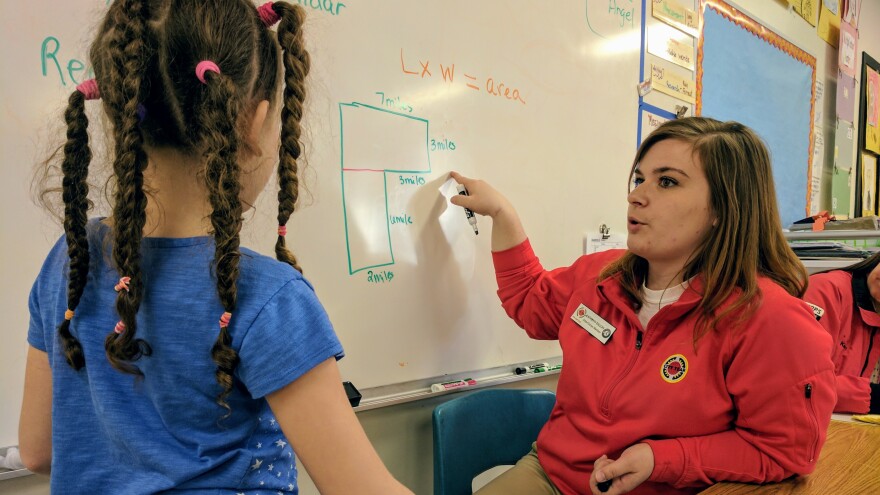With 14,000 students from a huge variety of backgrounds, the Manchester School District is both the largest and most diverse in the state.
But those distinctions come with challenges that sometimes result in stark disparities between schools just a few miles apart.
Beech Street and Green Acres are two elementary schools in Manchester. They’re about the same size; they’re only about three miles apart, and a few months ago, they were both teaching the same math lesson.
At Green Acres, Erin Chubb leads her 3rd grade class through a math problem on area and perimeter. Meanwhile at Beech Street, Kathryn Dillon is helping a student work through a similar problem.
Dillon isn’t a teacher though, she’s with the non-profit City Year. The group puts AmeriCorps members into urban, high-needs schools around the country - including 8 schools here in Manchester.
The math lesson may be the same at Green Acres and Beech Street, but a look at the data shows there’s a lot that separates these two schools.

The kids in that Green Acres classroom - they score right around the state average on standardized tests and they tend to come from well-kept suburban homes.
At Beech Street, smack in the middle of Manchester’s dense downtown, the vast majority of students come from poor households. Many are refugees and immigrants new to the city. For many kids, school is an oasis in an otherwise rocky home life, says Beech Street principal Christine Brennan.
“What’s reflected in the news is what’s reflected in some of the families. There’s a lot of opioid crisis that we’re aware of – we’ve had a lot of parents who’ve passed away," explains Brennan. "We’ve had people from war-torn countries. And so they face a lot of traumatic situations that are happening at home.”
So, how does one school district with these two very different student populations, provide an adequate education to both?
One way is through outside groups like City Year. The non-profit puts 70 young adults into the city’s neediest schools where they provide mentorship for students and support for teachers.

Brennan says they make a huge big difference at Beech Street. In fact, she says they couldn’t get by without them.
“I think that Beech Street needs City Year," says Brennan. "I think the students need City Year.”
But outside groups like City Year are often funded by outside money. Last year only 3 percent of City Year Manchester’s budget came from the school district. The rest came from federal sources and private philanthropy.
When it comes to the school district’s money, it sends roughly the same amount per student to both schools - about $11,000 a kid.
Which raises a question: should the district send more money to a school like Beech Street than it does to a school like Green Acres? Should kids with more needs get more money? I put this question to Manchester Superintendent Bolgen Vargas.
“I would love to do it and I think it’s the right thing to do,” says Vargas.
But Vargas says he can’t, because he doesn’t have the money.
For that, he blames a string of state decisions that over the years have shifted costs from Concord to local communities. Things that the state used to help with like the pension system for teachers or school building aid now rest squarely on the shoulders of towns and cities.
“The pension system is killing us,” says Vargas, noting it costs the district roughly $11 million a year.
School districts across New Hampshire have been squeezed financially because of these decisions, but Vargas says it is compounded in a place like Manchester which has concentrations of poverty.
“Sadly, in Manchester, the conflicting interests – meeting that need, has resulted in less services for kids, particularly for children that have tremendous need.”

Others point to city policies like Manchester’s tax cap as a source of financial stress. City officials say they do their best to balance the needs of the schools with the capacity of local tax payers.
And underlying all of this is an even bigger question –too big for this story– about whether more money in schools is the best way to address the social ills that many students grapple with.
The pressures on Manchester can make for a difficult budget season. Just a few months ago the district announced a round of teacher layoffs.
Back at Beech Street, outside groups like City Year are filling the hole.
Fourth grade teacher Jessica Gagnon is juggling a class of about 25 kids. It’s a lot to handle. But she gets help from City Year member Adam McCafee, who is in the class four days a week.
I ask Gagnon, as kids tug on her sleeves, what it’s like to have an extra adult in the room.
“Awesome. Amazing. Helpful, because as you can see I don’t have any other support throughout the day. I basically just have – it’s me, and then when he’s available I have him.”
And with that, Gagnon had to get back to work.








